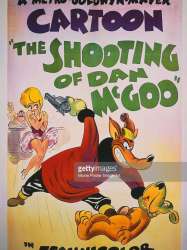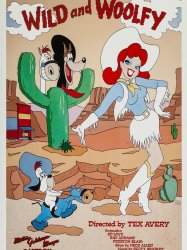Metro-Goldwyn-Mayer cartoon studio

- Infos
- Best films
If you like this company, let us know!
The Metro-Goldwyn-Mayer cartoon studio was the in-house division of Metro-Goldwyn-Mayer (MGM) motion picture studio in Hollywood, responsible for producing animated short subjects to accompany MGM feature films in Loew's Theaters. Active from 1937 until 1957, the cartoon studio produced some of the most popular cartoon series and characters in the world, including the famous cartoons Barney Bear and Droopy, but particularly its most important creation, Tom and Jerry.
Prior to forming its own cartoon studio, MGM released the work of independent animation producer Ub Iwerks, and later the Happy Harmonies series from Hugh Harman and Rudolf Ising. The MGM cartoon studio was founded to replace Harman and Ising, although both men eventually became employees of the studio. After a slow start, the studio began to take off in 1940 after its short The Milky Way became the first non-Disney cartoon to win the Academy Award for Best Short Subjects: Cartoons. The studio's roster of talent was benefited from an exodus of animators from the Schlesinger and Disney studios, who were facing issues with union workers.
Originally established and run by executive Fred Quimby, in 1955 William Hanna & Joseph Barbera, the writer-directors of the Tom and Jerry cartoons, became the heads of the studio. The cartoon studio was closed in mid-1957, at which time Hanna and Barbera took much of the staff to form their own company, Hanna-Barbera Productions.
Filmography of Metro-Goldwyn-Mayer cartoon studio (6 films)
Production

Daredevil Droopy (1951)
, 6minutesDirected by Tex Avery
Origin USA
Genres Comedy, Animation
Themes Films about animals, Films about dogs, Mise en scène d'un mammifère
Actors Bill Thompson, Tex Avery, Daws Butler, Shepard Menken
When a circus arrives to town, it features it's famous attractions including "The Great Barko and His Famous Acrobatic Dogs". And under the commertial posters an advertisement stands, titled "Dare Devil Dog Wanted", advertising a job for Barko's new dog-acrobats, under the condition "Must be Fearless!". This attracts both Droopy and Spike's attention to apply for the job. Satisfied with the reply from the two dogs, Barko decides to put the situation on the competitive basis: "The one that gives me the best performance in strength and daring, gets the job!", to which the dogs agree. During every tryouts - "see Simpson the Strong Man" test of strength, ringing the bell, "Pop the Balloons" shooting, "See a Woman Sawed in Half", "The Flying Human" flight test with a propeller on the head, riding a car through a sollid brick wall, "The Sharp Shooter", juggling, riding on a motorcycle through a ring of fire, flying on the trapeze, tightrope-walking, figure skating and "The Human Bullet" shoothing out of the cannon - Spike tries to overbest Droopy and sabotage his performances, to which he fails every time and gets himself injured a couple of times. During Droopy's final act, Spike tryes to sabotage the other again, by burning his foot with a matchstick. But this leads Droopy to perform faster, leaving the audience to applaud and gives him a minor burnt on the foot. Impressed with Droopy's successful performances, Barko hires him to be one of his Acrobatic Dogs. Outraged, Spike tries to cut the pole and timber it on both Droopy and Barko, but instead - it lands on Spike, leaving him the loser.

The Shooting of Dan McGoo (1945)
, 8minutesDirected by Tex Avery
Origin USA
Genres Comedy, Animation, Western
Themes Films about animals, Films about dogs, Mise en scène d'un mammifère
Actors Bill Thompson, Tex Avery, Frank Graham, Bea Benaderet, Paul Frees, Pinto Colvig
This starts off as an adaptation of Robert W. Service's poem in spoof of The Shooting of Dan McGrew, complete with a literal depiction of a man with one foot in the grave, but when Dan McGoo turns out to be Droopy, it turns into another Droopy-versus-the Wolf/Wolf-goes-ape-for-the-girl gagfest.

Wild and Woolfy (1945)
, 7minutesDirected by Tex Avery
Origin USA
Genres Comedy, Animation, Western
Themes Films about animals, Films about dogs, Mise en scène d'un mammifère
Actors Paul Frees, Tex Avery, Bea Benaderet, Bill Thompson, Pinto Colvig
In this western-themed cartoon, the Big Bad Wolf, now playing a cowboy criminal called "Joe" Wolf in this cartoon, kidnaps the cowgirl singer, Red (played by Red Hot from Red Hot Riding Hood) from Rig-R-Mortis saloon, where their motto is "Come in and get stiff." Droopy and a posse of cowboys doggedly follow him all over the Great Plains (mainly Droopy), but the wolf is far ahead. However, like in the previous cartoons, Droopy shows up in the places the wolf doesn't expect, forcing him to call for the waiter to keep Droopy away from him.

Who Killed Who? (1943)
, 8minutesDirected by Tex Avery
Origin USA
Genres Drama, Comedy, Animation
Themes Serial killer films
Actors Robert Emmett O'Connor, Billy Bletcher, Tex Avery, Sara Berner, Kent Rogers, Richard Haydn
A live-action host (Robert Emmett O'Connor) opens with a disclaimer about the nature of the cartoon, namely, that the short is meant to "prove beyond the shadow of a doubt that crime does not pay."
 , 4minutes
, 4minutesDirected by Bob Clampett, Friz Freleng, Rudolf Ising, Chuck Jones, Frank Tashlin
Origin USA
Themes Political films
Actors Mel Blanc
Distribution
 , 43minutes
, 43minutesDirected by Gene Deitch, Chuck Jones, Maurice Noble, Abe Levitow
Themes Children's films
The series features comedic fights between an iconic set of adversaries, a house cat (Tom) and mouse (Jerry). The plots of each short usually center on Tom's numerous attempts to capture Jerry and the mayhem and destruction that follows. Tom rarely succeeds in catching Jerry, mainly because of Jerry's cleverness, cunning abilities, and luck. However, there are also several instances within the cartoons where they display genuine friendship and concern for each other's well-being. At other times, the pair set aside their rivalry in order to pursue a common goal, such as when a baby escaped the watch of a negligent babysitter, causing Tom and Jerry to pursue the baby and keep it away from danger.
 Connection
Connection